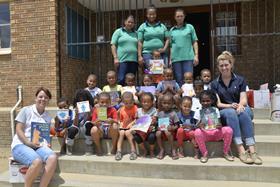
Early in 2008, South Africa’s stonefruit growers were preparing to launch their first integrated international market development campaign since the deregulation of the country’s fruit industry a decade earlier. Some small-scale private and industry promotions had been run on South African fruit in the previous ten years, but this new initiative was to be larger and hopefully longer lasting than what had gone before.
A financial crisis was descending on the world so trading was expected to be tough, but growers maintained they were “cautiously optimistic” about the prospects for their ‘Beautiful Country, Beautiful Fruit’ campaign and the 2008-09 season that lay ahead. In the UK, the first market earmarked for growth, consumers were becoming aware of the health benefits of eating fresh fruit, while quality was increasingly good. Meanwhile, as an obesity epidemic loomed, the government was putting more energy into encouraging healthy eating habits too.
A pilot campaign on South African plums was launched to the trade later that year, with a larger launch in London early in January 2010. This set out to test both the promotional model and the goodwill of essential stakeholders in the project, including retailers, suppliers and journalists.
The plan included above-the-line media activity including advertising, advertorials, radio and public relations, and promotion in retailers at the point of sale, complemented by direct engagement with buyers and marketing teams.
South Africa set out to approach the two categories in which the campaign runs, differently. In stonefruit, the South African season has traditionally coincided with an annual lull in sales, so activity has focused on retailers, showing shoppers the benefits of eating peaches, nectarines and plums during the UK winter, and providing opportunities to discover the eating quality of the fruit firsthand. This has been supported by work with magazines and bloggers to showcase the fruit while it’s in season.
In topfruit, where there is intense competition from other countries of origin on retailers’ shelves, the campaign has aimed to raise awareness of the flavour, freshness and ethical USPs of South African apples and pears in the media, so consumers are encouraged to make an active choice to buy South African.
The pilot was considered a success: supermarkets and the supply chain gave extremely positive feedback, and crucially sales increased. For the 2010-11 season, the campaign was rolled out further, across South African peaches, nectarines, apples and pears.
Ten years later and Beautiful Country, Beautiful Fruit has become an annual feature of the UK fresh produce calendar. A decade of investment in promotion has brought dividends in the form of strong relationships with the supply chain and media, while tangible results have kept growers’ support for market development high throughout successive renewal votes. Stonefruit sales have been a particular highlight, showing volume growth of just under 100 per cent over the ten years.
The results are a testament to the value of longevity when promoting fresh produce. In this seasonal industry, the stakeholders get closer to and more involved in a campaign every year that it runs; this has certainly been South Africa’s experience. According to Hortgro, engaging suppliers, retailers and writers has played a critical role in the performance.
As the campaign moves through its tenth anniversary year, you can see examples of the fruits of these collaborations. The Help a South African School initiative, running for its seventh successive season, sees UK schoolchildren learn about SA fruit and donate books to schools in the Western Cape; the project is made possible by contributions of time and resources by courier company MyHERMES, shippers Maersk and Damco, and other third parties.
The South African Young Chef of the Year competition, meanwhile, is moving towards the cook-off stage. The competition educates young chefs, engages colleges and restaurants and creates young ambassadors for South African fruit.
The campaign communicates with consumers themselves with a range of activities, from advertising and advertorial articles on the taste, season and ethical reasons for buying SA fruit in the press, online and outdoor sites; recipe and other editorial features, video and social media.
Promotions – such as this year’s “Win a South African Journey” holiday competition on packs of South African fruit – advertising interventions on retailer websites and initiatives to educate store staff, are an essential last part of the jigsaw. Retailers contribute to this stage in myriad ways, from putting the SA flag logo on packs to help shoppers identify SA fruit, to upweighting activity such as in-store sampling and online advertising and even increasing shelf space at key times.






No comments yet